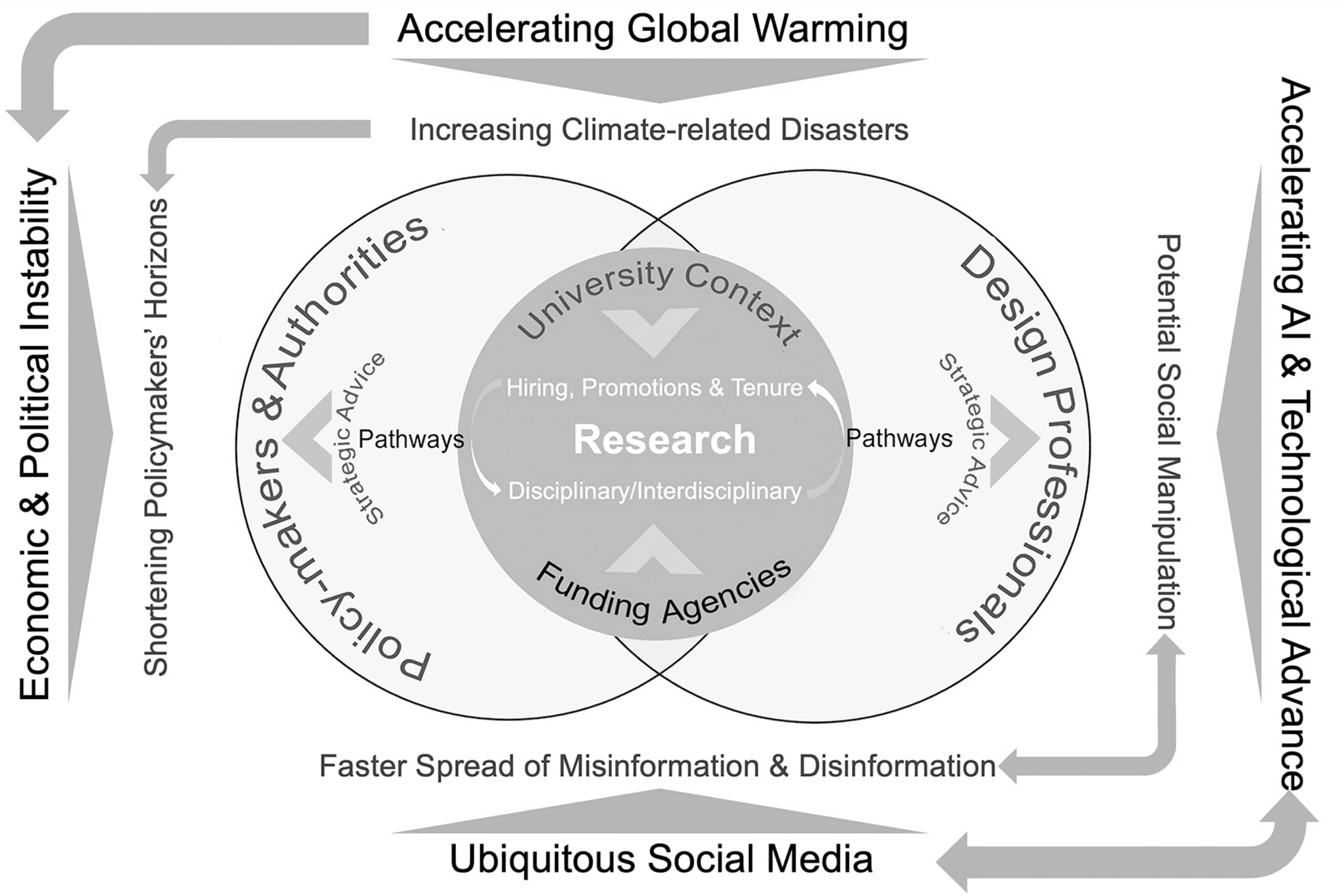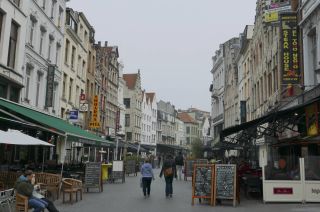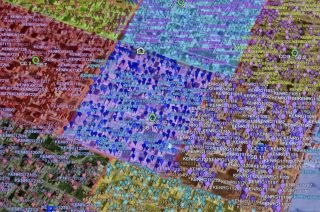
www.buildingsandcities.org/insights/commentaries/research-changing-uncertain-world.html
Research in a Rapidly Changing and Increasingly Uncertain World

Challenges ahead: how the conduct of research needs to change
How might the conduct of research need to change in the future? What are the lessons for built environment research from the Covid pandemic? Raymond J Cole (University of British Columbia) considers whether and why knowledge production outside the purview of disciplinary-based research is increasing needed. Addressing rapid change and the complex multi-faceted consequences of a warming climate will challenge existing research methodologies and is likely to require increased interdisciplinarity. New ways of working will also require overcoming organisational barriers and a deeper understanding of the needs of decisionmakers.
Most academic research is domain specific. As in other fields, research related to the built environment is directly or indirectly shaped by broader societal priorities, the issues that are considered urgent, worthy of attention or of particular interest to researchers, and what the funding agencies are prepared to support. Moreover, the way that the built environment is produced, maintained, inhabited or reimagined, changes over time in response to economic booms and busts, environmental and climate threats, technological advances, regulation updates, demographic shifts, political visions and the public's expectations. Relevant knowledge is needed to guide decision-making by authorities and regulatory bodies, support building practice, and inform the public.
While existing knowledge and experience can confidently be drawn upon when the problems and issues are broadly known, novel research is needed to provide the necessary understanding and strategic direction when they are not. Of interest here is: if and how periods of rapid change and unforeseen crises create a different set of methodological challenges for research and affect the pathways by which its outputs enter decision-making.
The COVID-19 crisis: following the science?
In December 2019, a small number of patients in the city of Wuhan, China experienced symptoms of an atypical pneumonia-like illness irresponsive to standard medical treatments and procedures. Within a matter of months, governments worldwide struggled to cope with the rapid increase in the hospitalisation of citizens infected with COVID-19, expediting the development of vaccines, medical equipment and testing protocols,the straining of social systems, providing guidance to the public on staying safe, and enforcing strategies like lockdowns and furloughs - all of which unfolded amidst growing public backlash and disinformation campaigns. The pandemic accelerated the shift to remote working, increased the time people spent at home, shifted the ways dwellings were used, and influenced what constituted desirable places to live. Moreover, exacerbated by geopolitical instability, disruptions in supply chains and labour significantly increased production costs for new buildings. The context and lens for viewing buildings has changed as has what and how research is conducted.
Although COVID-19 and its direct impacts have subsided, the public health crisis exposed five relevant research-related issues. First, during the three-year pandemic, huge amounts of government funding were channelled to research and innovation-the UK government, for example, funded 1,200 awards with a total value of more than £0.5bn. Second, a considerable body of literature emerged showing relationships between the built environment and COVID. Although facing 'identical' objectives, different research methodologies yielded 'varying results and conclusions' (Haowei et al. 2024) and the advice provided by different scientific disciplines did not always align. Indeed, conflicting messages from authorities to promote responsible public behaviours diminished confidence in both health scientists and politicians. Third, 'rigorous and credible science' is typically slow, not amenable to being rushed (Gleick 2020), and 'not necessarily conducive to formulating policy in a rapidly changing global health crisis' (EBioMedicine 2020). Fourth, adopted strategies invariably were simplifications of what research was providing. For example, while health science recognised that distancing rules should take account of multiple factors including viral load, ventilation, type of activity, whether indoors or outdoors, and masking (Qureshi et al. 2020), 2 m became the universal, unambiguous and implementable criteria. Fifth, the relationship between the scientific and political bases of major decisions came into sharp focus. While governments continually announced that they were 'following the science' as justification of their strategic decision-making regarding social distancing and lockdowns, it was pitted against and often came secondary to those prioritising economic or other political demands.
A warming climate: an increasingly uncertain future?
The pandemic-that killed more than 7 million people worldwide-was declared over in May 2023. While it dominated political and public attention, COVID-19 occurred amidst an increase in the frequency of climate-related catastrophes-events that are now growing in scale and intensity, and at an unprecedented accelerating rate. The aggressive curbing of GHG emissions remains essential to prevent the planet reaching irreversible tipping points and finding pathways to 'net zero' has emerged as a major political challenge and generated significant research activity. However, irrespective of reductions that are made over the next decade or so, cities will increasingly experience prolonged heatwaves, and their inhabitants exposed to significantly higher daily maximums and warmer nights. Indeed, many buildings may be unable to remain habitable during extreme weather events and power outages.
The fallacy of the commonly held notion that building 'occupants' being passive recipients of the conditions provided by design became evident with the unanticipated ways that people used buildings during the pandemic. Similarly, navigating an uncertain and difficult future created by a warming climate will no doubt further require them to employ any adaptive opportunities available in buildings, and for researchers and design professionals to reframe the relationship between 'inhabitant' behaviour and building systems as a 'multidirectional and interactive' rather than as a 'linear or predictable' one (Cole et al. 2008). However, enabling personal agency stands counter to the current trend of removing control from building inhabitants to optimise their comfort by placing reliance on increasingly sophisticated 'intelligent' systems. Similar arguments can be made if 'informal' opportunities are integrated within existing formal planning systems to permit community groups greater licence. This challenge to the current distribution of power shaping the built environment will likely gain strength as the climate emergency becomes more acute and when authorities struggle to manage the risks it poses.
Challenges for discipline-specific research
Researchers face new challenges with the increase in the type and complexity of impacts that a changing climate has on human and natural systems. Here, research has four relevant characteristics. First, researchers 'handle reality in different ways' (Mol & Hardon 2020), typically follow the protocols of their respective disciplines, and draw on relevant extant literature to situate and justify the new work and to support its key assertions and methodology. Second, like all experts, academic researchers are typically comfortable speaking to those in their own field who share common goals, that permit using specialised language and making presumptions about prior knowledge (Bogost 2018). This is typically not the case when engaging the many diverse 'publics' within any society-including other academic disciplines-each having different knowledge, interests and priorities. Here equipping researchers with skills to be more comfortable and effective in communicating their work largely falls on those who train them. Third, building-related research is typically directed at finding answers to specific and known problems. While evidence-based design has raised the expectation that founding decisions on credible research will achieve the best possible outcomes, such a process is further challenged within a rapidly changing world and warming climate with unknown outcomes. Fourth, research publications largely reside within domain literature and few key findings enter the public domain. Here, Perga et al. (2023) illustrated that the 'news media preferentially publicises research outputs found in multidisciplinary journals and journals perceived as top-tier,' and that it 'showcases a narrow and limited facet of climate change knowledge.'
Challenges for interdisciplinary research

Climate scientists face the challenge of educating and mobilising society on the urgent need to confront the threats posed by a warming climate. While building-related researchers must reinforce this urgency, their challenges extend to understanding the complex, multifaceted consequences for the built environment and how to accelerate its transformation amidst a host of other pressing social and economic issues. This requires more integrated approaches to knowledge production that fall outside the purview of disciplinary-based research and overcoming a host of barriers within the institutional where it research conducted. Moreover, while interdisciplinary research may draw on and combine disciplinary knowledge and expertise, it has its own 'theoretical and conceptual bases outside or between disciplines' (Robinson 2024).
The traditional organisation of universities into distinct discipline-based departments does not typically foster an environment that supports research collaboration and interdisciplinarity. 'Cluster hiring' researchers to work together in centres and institutes or making boundaries between academic disciplines more porous, does not guarantee successful interdisciplinary research without addressing a host of other issues: the basis of promotion and tenure decisions, flexibility in appointments, career development (Brown 2024), funding opportunities, and valuing research published in interdisciplinary journals.
COVID-19 not only revealed the difficulties of decision-making accommodating the outputs of research in a rapidly changing context, but exposed how little was known about 'learning under stress and urgency in the middle of a crisis' and the need to 'understand the relationship between crises and public responses' (Weible et al. 2020). Moreover, addressing the pandemic was clearly not solely a scientific, technical or health problem and its broader sociological dimensions required an understanding of complex individual and collective human actions in response to the health threats it posed.
The impacts of a warming climate will extend well into the future and climate-related crises will get progressively more frequent and costly. While we cannot know what new challenges built environment research will face in this emerging context, having better understanding the pathways from research to decision-making is likely to become increasingly necessary (Vorley et al. 2022). This includes, for example, being more cognisant of what decision-makers require from research and how to set research output amongst the plethora of other often conflicting issues that they face when formulating policies and selecting strategies. Here, Robinson's (2024) positionthat addressing complex societal problems requires combining 'academic expertise with other forms of knowledge through strong partnerships with non-academic partners,' is particularly apt. Otherwise, as a warming climate pushes us into an increasingly uncertain and unknown world, decisions made by political leaders, authorities and building design professionals may be less based on guidance provided by research but drawn further from intuition or, equally troubling, outmoded knowledge.
References
Bogost, I. (2018). The myth of 'dumbing down'. The Atlantic. https://www.theatlantic.com/science/archive/2018/10/scholars-shouldnt-fear-dumbing-down-public/573979/
Brown, R.A. (2024). University hiring must be centrally organised around interdisciplinarity. Times Higher Education, 30 January 2024. https://www.timeshighereducation.com/opinion/university-hiring-must-be-centrally-organised-around-interdisciplinarity
Cole, R.J., Robinson, J.R., Brown, Z. & O'Shea, M. (2008). Re-contextualising the notion of comfort. Building Research & Information, 36:4, 323-336. https://www.tandfonline.com/doi/abs/10.1080/09613210802076328
EBioMedicine. (2020). COVID-19: A time for renewed recognition of science (editorial). EBioMedicine. https://doi.org/10.1016/j.ebiom.2020.102869
Haowei, Y., Mahyuddin, N., Ghazali, N.N.B.N., Wang, Z., Liu, Y., Pan, S. & Badruddin, I.F. (2024) A critical review of research methodologies for COVID-19 transmission in indoor built environment. International Journal of Environmental Health Research. https://doi.org/10.1080/09603123.2024.2308731
Mol, A. & Hardon, A. (2020). What COVID-19 may teach us about interdisciplinarity. BMJ Global Health, 5:12. https://doi.org/10.1136/bmjgh-2020-004375
Perga, M-E, Sarrasin, O., Steinberger, J., Lane, S.N., & Butera, F. (2023). The climate change research that makes the front page: Is it fit to engage societal action? Global Environmental Change, 80, 102675. https://doi.org/10.1016/j.gloenvcha.2023.102675
Qureshi, Z., Jones, N., Temple, R., Larwood, J.P.L., Greenhalgh,T.L. & Bourouiba,L. (2020). What is the evidence to support the 2-metre social distancing rule to reduce COVID-19 transmission? The Centre for Evidence-Based Medicine. https://www.cebm.net/covid-19/what-is-the-evidence-to-support-the-2-metre-social-distancing-rule-to-reduce-covid-19-transmission/
Robinson, J.B. (2024). Deep interdisciplinarity and transdisciplinary knowledge co-production, IN: Darbellay, R. (ed.) Elgar Encyclopedia of Interdisciplinarity and Transdisciplinarity. Cheltenham: Edward Elgar, 152-56.ISBN: 978 1 0353 1975 0
Vorley, T., Rahman, S.A., Tuckerman, L. & Wallace, P., eds. (2022). How to Engage Policy Makers with Your Research: The Art of Informing and Impacting Policy. Cheltenham: Edward Elgar. ISBN: 978 1 80037 895 7
Latest Peer-Reviewed Journal Content
Acceptability of sufficiency consumption policies by Finnish households
E Nuorivaara & S Ahvenharju
Key factors for revitalising heritage buildings through adaptive reuse
É Savoie, J P Sapinski & A-M Laroche
Cooler streets for a cycleable city: assessing policy alignment
C Tang & J Bush
Understanding the embodied carbon credentials of modern methods of construction
R O'Hegarty, A McCarthy, J O'Hagan, T Thanapornpakornsin, S Raffoul & O Kinnane
The changing typology of urban apartment buildings in Aurinkolahti
S Meriläinen & A Tervo
Embodied climate impacts in urban development: a neighbourhood case study
S Sjökvist, N Francart, M Balouktsi & H Birgisdottir
Environmental effects of urban wind energy harvesting: a review
I Tsionas, M laguno-Munitxa & A Stephan
Office environment and employee differences by company health management certification
S Arata, M Sugiuchi, T Ikaga, Y Shiraishi, T Hayashi, S Ando & S Kawakubo
Spatiotemporal evaluation of embodied carbon in urban residential development
I Talvitie, A Amiri & S Junnila
Energy sufficiency in buildings and cities: current research, future directions [editorial]
M Sahakian, T Fawcett & S Darby
Sufficiency, consumption patterns and limits: a survey of French households
J Bouillet & C Grandclément
Health inequalities and indoor environments: research challenges and priorities [editorial]
M Ucci & A Mavrogianni
Operationalising energy sufficiency for low-carbon built environments in urbanising India
A B Lall & G Sethi
Promoting practices of sufficiency: reprogramming resource-intensive material arrangements
T H Christensen, L K Aagaard, A K Juvik, C Samson & K Gram-Hanssen
Culture change in the UK construction industry: an anthropological perspective
I Tellam
Are people willing to share living space? Household preferences in Finland
E Ruokamo, E Kylkilahti, M Lettenmeier & A Toppinen
Towards urban LCA: examining densification alternatives for a residential neighbourhood
M Moisio, E Salmio, T Kaasalainen, S Huuhka, A Räsänen, J Lahdensivu, M Leppänen & P Kuula
A population-level framework to estimate unequal exposure to indoor heat and air pollution
R Cole, C H Simpson, L Ferguson, P Symonds, J Taylor, C Heaviside, P Murage, H L Macintyre, S Hajat, A Mavrogianni & M Davies
Finnish glazed balconies: residents' experience, wellbeing and use
L Jegard, R Castaño-Rosa, S Kilpeläinen & S Pelsmakers
Modelling Nigerian residential dwellings: bottom-up approach and scenario analysis
C C Nwagwu, S Akin & E G Hertwich
Mapping municipal land policies: applications of flexible zoning for densification
V Götze, J-D Gerber & M Jehling
Energy sufficiency and recognition justice: a study of household consumption
A Guilbert
Linking housing, socio-demographic, environmental and mental health data at scale
P Symonds, C H Simpson, G Petrou, L Ferguson, A Mavrogianni & M Davies
Measuring health inequities due to housing characteristics
K Govertsen & M Kane
Provide or prevent? Exploring sufficiency imaginaries within Danish systems of provision
L K Aagaard & T H Christensen
Imagining sufficiency through collective changes as satisfiers
O Moynat & M Sahakian
US urban land-use reform: a strategy for energy sufficiency
Z M Subin, J Lombardi, R Muralidharan, J Korn, J Malik, T Pullen, M Wei & T Hong
Mapping supply chains for energy retrofit
F Wade & Y Han
Operationalising building-related energy sufficiency measures in SMEs
I Fouiteh, J D Cabrera Santelices, A Susini & M K Patel
Promoting neighbourhood sharing: infrastructures of convenience and community
A Huber, H Heinrichs & M Jaeger-Erben
New insights into thermal comfort sufficiency in dwellings
G van Moeseke, D de Grave, A Anciaux, J Sobczak & G Wallenborn
'Rightsize': a housing design game for spatial and energy sufficiency
P Graham, P Nourian, E Warwick & M Gath-Morad
Implementing housing policies for a sufficient lifestyle
M Bagheri, L Roth, L Siebke, C Rohde & H-J Linke
The jobs of climate adaptation
T Denham, L Rickards & O Ajulo
Structural barriers to sufficiency: the contribution of research on elites
M Koch, K Emilsson, J Lee & H Johansson
Disrupting the imaginaries of urban action to deliver just adaptation [editorial]
V Castán-Broto, M Olazabal & G Ziervogel
Nature for resilience reconfigured: global- to-local translation of frames in Africa
K Rochell, H Bulkeley & H Runhaar
How hegemonic discourses of sustainability influence urban climate action
V Castán Broto, L Westman & P Huang
Fabric first: is it still the right approach?
N Eyre, T Fawcett, M Topouzi, G Killip, T Oreszczyn, K Jenkinson & J Rosenow
Social value of the built environment [editorial]
F Samuel & K Watson
Understanding demolition [editorial]
S Huuhka
Data politics in the built environment [editorial]
A Karvonen & T Hargreaves



Latest Commentaries
Decolonising Cities: The Role of Street Naming
During colonialisation, street names were drawn from historical and societal contexts of the colonisers. Street nomenclature deployed by colonial administrators has a role in legitimising historical narratives and decentring local languages, cultures and heritage. Buyana Kareem examines street renaming as an important element of decolonisation.
Integrating Nature into Cities
Increasing vegetation and green and blue spaces in cities can support both climate change mitigation and adaptation goals, while also enhancing biodiversity and ecological health. Maibritt Pedersen Zari (Auckland University of Technology) explains why nature-based solutions (NbS) must be a vital part of urban planning and design.